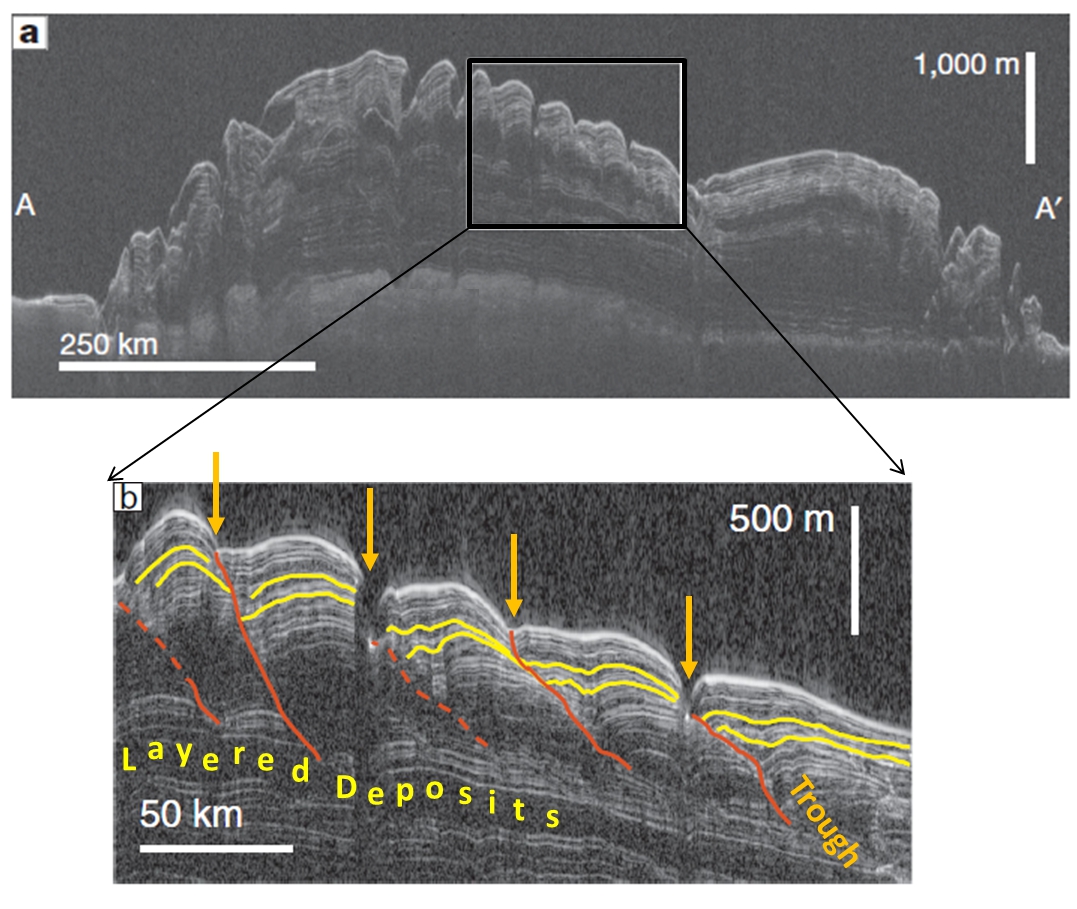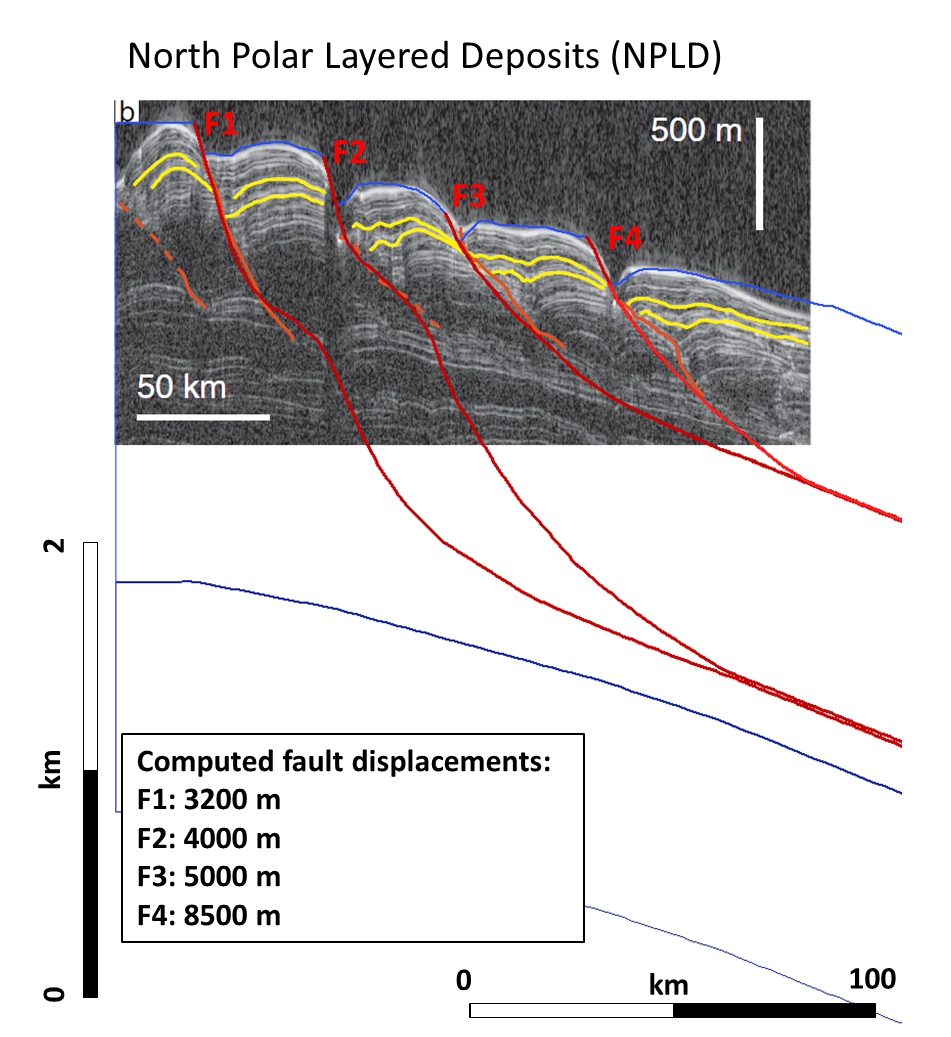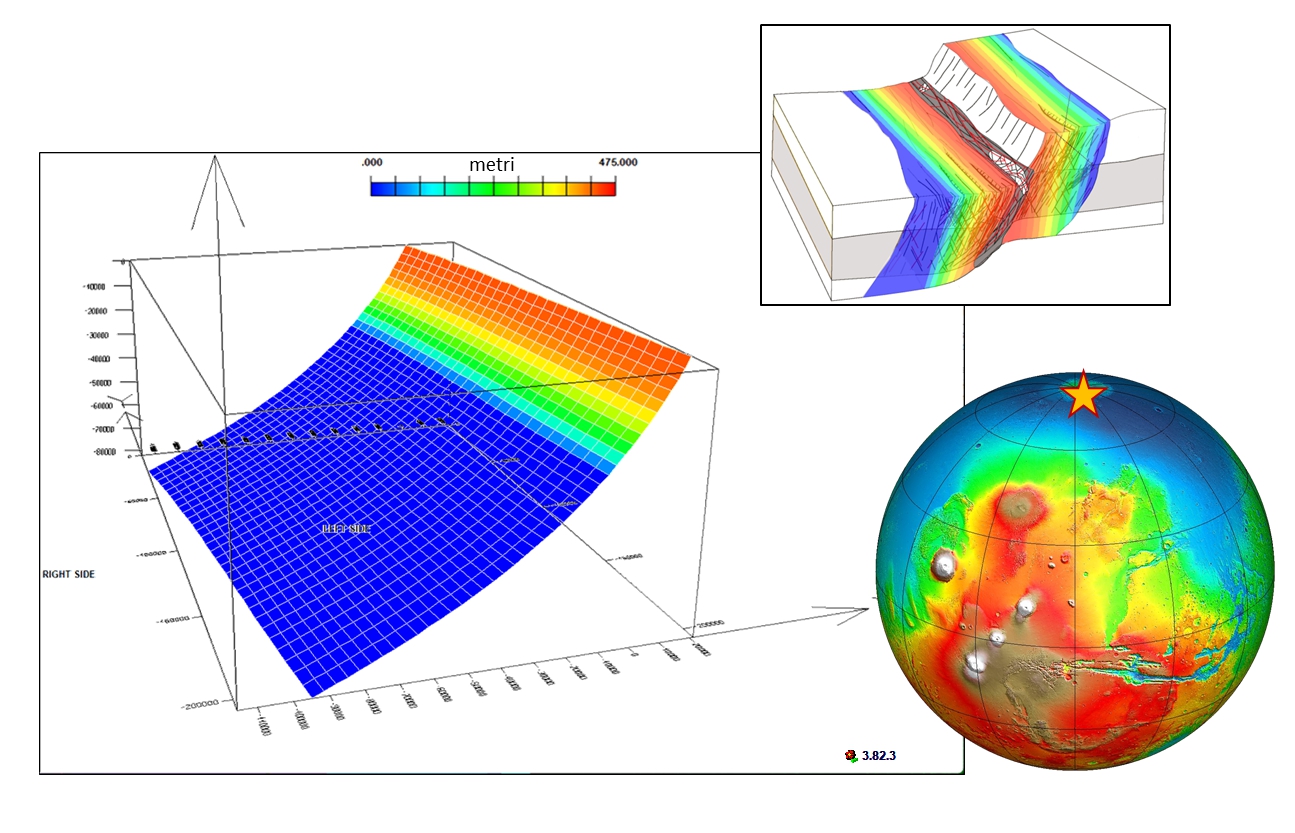Structural glaciology of the Martian ice caps unveils conduits for fluid migrations
- 1Genova, DISTAV - Dipartimento di Scienze della Terra, dell'Ambiente e della Vita, Genova, Italy (paola.cianfarra@unige.it)
- 2Dipartimento di Scienze -GeoQuTe Lab, Università degli Studi Roma Tre, Roma, Italia
The increasing availability of radar sub-surface/surface imaging of the terrestrial planets allowed to highlight the structural architecture of buried geological structures. The reconstruction of the 3D subsurface geometries, besides supporting the classic geologic mapping of planetary surfaces, allows to constrain models to unravel the 4D evolution of a region. This is of utmost importance in key regions where trapped subsurface fluids and their (possible) migration to the surface might impact local/global climate conditions , atmospheric composition, as well as the presence of water close to the maritan surface.
Shallow Subsurface Radar (SHARAD) data [1] revealed that the Martian caps are composed primarily of water ice that was deposited in layers that contain varying amount of dust. They are referred to as martian Polar Layered Deposits (PLD). The internal stratigraphy of these deposits strongly resemble the internal layering in key sites of the East Antarctic Ice Sheet, where the ice tectonics (e.g. ice faulting) and dynamics, revealed to be the causes of the observed architecture.
Mechanisms responsible for the formation and evolution of the martian PLD are still under debate and exogenous processes are considered among the best candidates [2]. Steep troughs dissecting the polar ice caps with spiral shapes provide an optimal view of the layered internal structures. Ice reflectors interpretations suggested a migration of these troughs accompanied by katabatic winds that produce erosion/sublimation at the exposed layers and accumulation/deposition at the opposite slopes [2]. Nevertheless, the SHARAD profiles crosscutting these canyons revealed the lateral change in thickness of ice layers, with thickening as they approach the canyon structures (Fig.1). It is well known from the terrestrial analogues/structures that such geometry may well result from the activity of normal faults with sintectonic sedimentation (ice and dust deposition in the martian case).

Figure 1. Sharad Image showing examples of the stratigraphic architecture of the North Polar Layered Deposits and spiral through dissecting the ice cap.
In this work we present the results the forward numerical modeling by HCA technique [3] of the PLD structure evolution.. The layered ice is simulated by a mesh of cells whose links replicate the physical and rheological characteristics of the material as well as the presence of ruptures such as faults. The observed ice stratigraphy of the PLD, the lateral thickness variations, and their vertical offset are successfully simulated through the activity of shear discontinuities with a series of listric shapes and normal displacements (Fig.2).

Figure 2. HCA numerical model of the ice layered deposits from Mars north polar region. Subset of SHARAD radargram 1294501 [3]
The HCA kinematic modeling thus revealed the existence faults with size of the order of hundreds of km within the Martian ice caps. Faults with similar size and displacement of the order of several kms are associated with well developed and extended fault core and damaged zones, characterized by strong variation in permeability due to secondary fracturing. In this way the martian ice cap faults produce corridors of brittle deformation that dissect the entire ice cap, provide conduits for fluid migration, and enhance the development of the observed troughs.
The width of the fault damaged zones is of the order of the hundreds of meters and the presence of the fault core, the attitude of fault-related fractures (synthetic fractures, antithetic fractures, extensional fractures, pressure solutions seams) and their spatial distribution and frequency in the ice volume affected by the damage zone of the shear discontinuities has been quantified by the analytical-numerical modeling performed with FRAP software using the found fault geometry [4]. This model takes into account the kinematic conditions of the modeled fault, the physical properties of the ice material and environmental parameters (e.g. acting stresses, gravity, fluid pressure …) which influence the computation of the secondary permeability (Fig 3).

Figure 3. Schematic 3D sketch showing the ice volume affected by fault-related fractures and the development of secondary permeability in the fault damage zone (example of FRAP output).
Results of this study represent a contribute to better understand the hitherto underestimated ice tectonic setting of the Martian ice caps. Highlighting the hydraulic properties of these faults is pivotal to understand the enhanced pathway of fluid that are trapped both within the ice layers and at the base of the ice caps. Fluids and biological material can thus approach the surface and the atmosphere and may be easily detectable/sampled to improve the success of future onland missions.
References
[1] Seu, R., Biccari, D., Orosei, R., Lorenzoni, L. V., Phillips, R. J., Marinangeli, L., ... & Zampolini, E. (2004). SHARAD: The MRO 2005 shallow radar. Planetary and Space Science, 52(1-3), 157-166.
[2] Smith, Holt, Spiga, Howard, Parker (2013). The spiral troughs of Mars as cyclic steps. Journal Of Geophysical Research: Planets, 118, 1835–1857.
[3] Salvini F. Storti F., McClay K (2001)) Self-determining numerical modeling of compressional
fault-bend folding. Geology, 29, 839-842.
[4] Salvini F. (2005). FRAP – Fault-Related fracturing by Analytic-numerical aPpproach. Inhouse developed application at the GEoQuTe Lab, Roma Tre University.
How to cite: Cianfarra, P., Salvini, F., Balbi, E., and Maggi, M.: Structural glaciology of the Martian ice caps unveils conduits for fluid migrations, Europlanet Science Congress 2022, Granada, Spain, 18–23 Sep 2022, EPSC2022-844, https://doi.org/10.5194/epsc2022-844, 2022.
Corresponding presentation materials formerly uploaded have been withdrawn.

